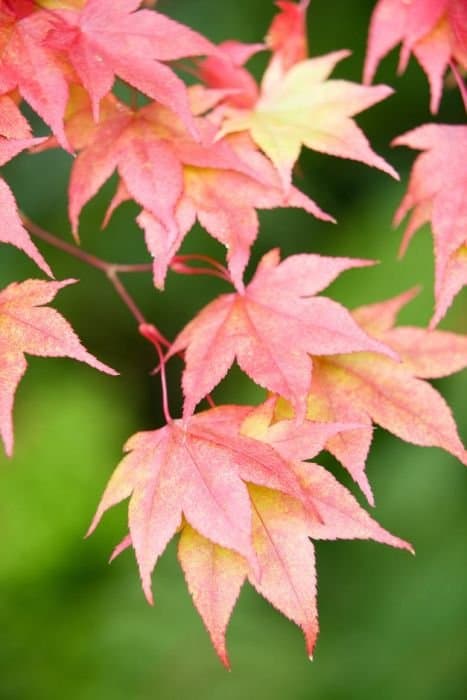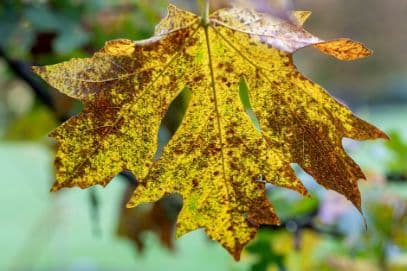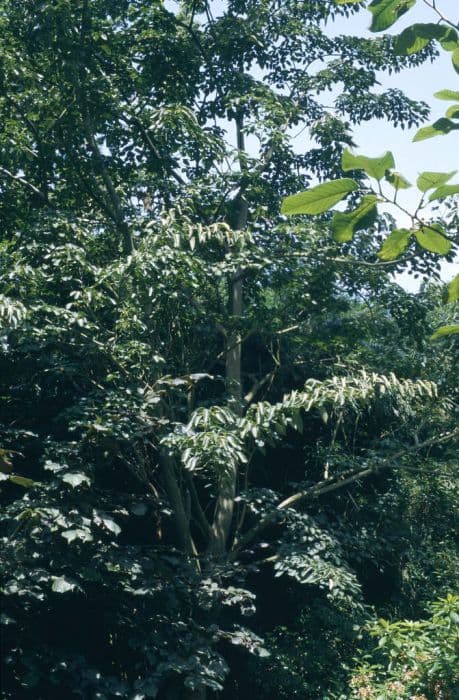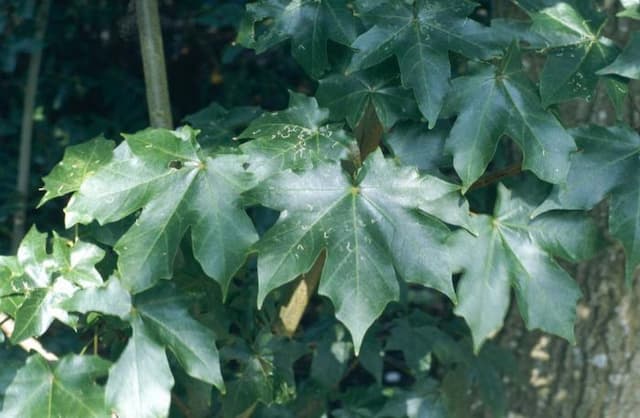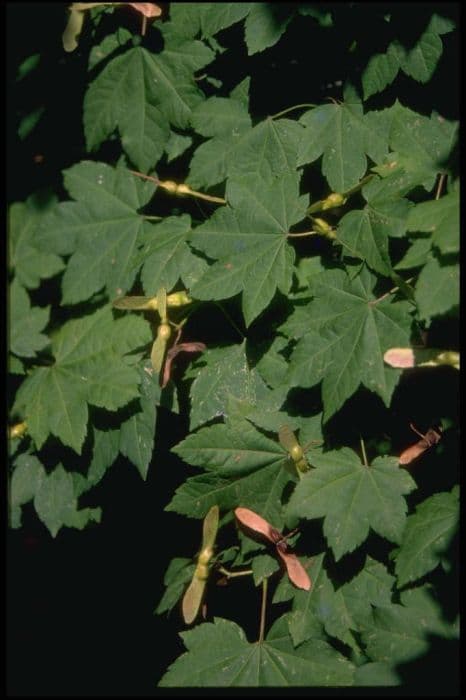Japanese Maple Acer palmatum 'Inaba-shidare' (D)

ABOUT
Acer palmatum 'Inaba-shidare', also known as the Japanese maple 'Inaba-shidare', is a striking ornamental tree notable for its beautiful foliage and elegant form. The leaves are deeply lobed and finely dissected, giving them an intricate lace-like appearance. The texture of the leaves is delicate, and they are generally arranged in a way that creates a cascading effect, much like a waterfall. The foliage displays a rich, vibrant purple-red color that can become even more intense as the cooler months approach. The lustrous leaves typically turn an array of vivid red to crimson tones in autumn, making it an excellent choice for adding seasonal interest to the landscape. This variety of Japanese maple also has an architectural branching structure that becomes an attractive feature in the winter landscape when the leaves have fallen. The bark of the Japanese maple 'Inaba-shidare' is smooth and gray, providing a subtle contrast to the flamboyant leaves. While this tree is primarily grown for its decorative leaves, it also produces small, inconspicuous reddish-purple flowers in the spring, which give way to samaras—winged seed pods—that are also reddish in color and add to the interest of the tree through the growing season. Exuding an aura of grace and tranquility, the Japanese maple 'Inaba-shidare' is a gorgeous addition to gardens where the focus is on visual interest through leaf shapes and colors, rather than the size or stature of the plants. Its sculptural form and stunning foliage offer a point of beauty throughout much of the year.
About this plant
 Names
NamesFamily
Sapindaceae
Synonyms
Japanese Maple, Red Laceleaf Japanese Maple, Inaba-shidare Cutleaf Maple
Common names
Acer palmatum 'Inaba-shidare'
 Toxicity
ToxicityTo humans
Japanese maple is not considered toxic to humans. Therefore, ingestion of this plant typically does not result in poisoning or produce harmful symptoms.
To pets
Japanese maple is generally not considered toxic to pets. It is usually safe in the landscape and does not cause poisoning if pets happen to ingest parts of the plant. However, as with any non-food plant, ingestion of large quantities could potentially cause mild stomach upset.
 Characteristics
CharacteristicsLife cycle
Perennials
Foliage type
Deciduous
Color of leaves
Red
Flower color
Red
Height
6-8 feet (1.8-2.4 meters)
Spread
4-5 feet (1.2-1.5 meters)
Plant type
Tree
Hardiness zones
5
Native area
Japan
Benefits
 General Benefits
General Benefits- Aesthetic appeal: Provides striking foliage color with deep purple-red leaves that can transform any garden into a visually stunning space.
- Seasonal interest: Offers year-round interest with leaves that change color throughout the seasons before shedding in the fall to reveal an attractive branch structure in the winter.
- Shade tolerance: Adapts well to a variety of lighting conditions, including partial shade, making it versatile for different garden settings.
- Cold hardiness: Resistant to low temperatures and can survive in colder climates, making it suitable for many temperate regions.
- Compact size: Grows to a manageable size that is ideal for small gardens or limited spaces, as well as containers and patios.
- Low maintenance: Requires minimal pruning and care, which is ideal for gardeners looking for plants that do not need constant attention.
- Wildlife support: Attracts beneficial insects and birds, contributing to the local ecosystem and biodiversity in the garden.
- Cultural significance: Often used in Japanese gardens, it brings a sense of tranquility and traditional aesthetic, enhancing the cultural value of the landscape.
 Medical Properties
Medical PropertiesThis plant is not used for medical purposes.
 Air-purifying Qualities
Air-purifying QualitiesThis plant is not specifically known for air purifying qualities.
 Other Uses
Other Uses- The Japanese Maple's wood can be used in woodworking to create small decorative items such as jewelry boxes or picture frames, due to its beautiful grain and texture.
- Leaves of the Japanese Maple can be pressed and preserved to be used in crafting, such as for botanical art or in scrapbooking, as their striking colors can add a unique touch to creative projects.
- Fine twigs and branches from the Japanese Maple can be used in floral arrangements to add height and visual interest with their elegant arching form and rich coloration.
- Japanese Maple trees can serve as a natural backdrop for photography, especially in autumn when the foliage provides a stunning array of colors.
- The cascading branches and delicate leaves of the Japanese Maple can be incorporated into garden ponds and water features to create natural-looking edges and overhangs.
- When dried, the seeds of the Japanese Maple can be used as beads in custom jewelry-making, giving pieces a natural and rustic aesthetic.
- The brightly colored leaves can be used in the culinary presentation, such as garnishing dishes or decorating cakes, after being treated to make them food safe.
- In bonsai culture, the Japanese Maple's branches can be carefully shaped and trained to create living sculptures, making it a favorite among bonsai enthusiasts.
- Leaves from the Japanese Maple are sometimes used in the art of leaf casting, where they leave their intricate impressions on plaster or cement for garden ornaments or stepping stones.
- The fallen leaves can be collected and used as a natural dye for fabrics, yielding colors ranging from green to golden yellow, and even orange or red depending on the processing method.
Interesting Facts
 Feng Shui
Feng ShuiThe Japanese Maple is not used in Feng Shui practice.
 Zodiac Sign Compitability
Zodiac Sign CompitabilityThe Japanese Maple is not used in astrology practice.
 Plant Symbolism
Plant Symbolism- Beauty: The Japanese Maple, including the 'Inaba-shidare' cultivar, is often associated with beauty due to its delicate and lace-like leaves as well as its stunning autumnal color change.
- Peace: In Japanese culture, the maple tree is a symbol of peace and serenity, providing a calm presence in any garden.
- Endurance and strength: Despite its delicate appearance, the Japanese Maple is known for its ability to withstand various climates, representing endurance and strength.
- Balance: The balanced and symmetrical growth habit of this maple cultivar symbolizes harmony and equilibrium in life.
- Welcoming: With its widespread canopy and attractive foliage, the Japanese Maple is seen as a welcoming plant, often used in traditional Japanese gardens to invite guests in.
 Water
WaterJapanese Maple trees, including the 'Inaba-shidare' variety, should be watered regularly but not excessively. The ideal method is deep watering, which means slowly soaking the soil to allow water to reach the roots rather than just wetting the surface. Typically, watering once a week with one to two gallons is sufficient, depending on the weather conditions. During hotter and dryer periods, water twice a week, while during cooler and rainy seasons you might water less frequently. Always check the top 2-3 inches of soil for dryness before watering to prevent overwatering.
 Light
LightJapanese Maples, such as the 'Inaba-shidare', thrive best in a location with partial shade to full sun. However, to protect the delicate leaves, it is advisable to provide some afternoon shade, particularly in hotter climates to prevent leaf scorch. A spot that gets morning sunlight with dappled afternoon shade would be ideal for this plant.
 Temperature
TemperatureJapanese Maples like the 'Inaba-shidare' prefer temperate conditions and can generally tolerate temperatures between 20°F and 90°F. The ideal temperature range for promoting growth and vibrant foliage is between 60°F and 80°F. However, this variety can withstand brief periods of colder weather and is hardy down to 0°F, but sustained extreme cold or heat can be damaging.
 Pruning
PruningPrune the 'Inaba-shidare' Japanese Maple to maintain its aesthetic weeping shape and to remove any dead or damaged branches. Pruning is best done in the late winter or early spring before new growth begins. Light annual pruning is usually sufficient, but you can prune more frequently to shape the tree or control its size. Always use clean, sharp tools to make precise cuts.
 Cleaning
CleaningAs needed
 Soil
SoilThe best soil mix for Japanese Maple 'Inaba-shidare' should be well-draining, with a mix of loam, peat, and pine bark. It prefers a soil pH of 5.5 to 6.5.
 Repotting
RepottingJapanese Maples like 'Inaba-shidare' should be repotted every 2-3 years, preferably in the late winter just before spring growth starts.
 Humidity & Misting
Humidity & MistingJapanese Maple 'Inaba-shidare' prefers moderate humidity but is adaptable to various humidity levels as long as the soil moisture is well-regulated.
 Suitable locations
Suitable locationsIndoor
Provide bright, indirect light and protect from harsh sun.
Outdoor
Part-shade, protection from severe weather.
Hardiness zone
5-8 USDA
 Life cycle
Life cycleJapanese Maple 'Inaba-shidare' begins its life as a seed, which germinates in favorable conditions of moisture and temperature, emerging as a seedling with characteristic lobed leaves. It enters a juvenile vegetative stage where it focuses on establishing a root system and producing foliage, developing its elegant, cascading branches over years. As the tree matures, it enters a reproductive phase, developing small reddish-purple flowers in spring which, if pollinated, produce winged samaras (seed pods) that mature by late summer to early fall. The Japanese Maple 'Inaba-shidare' exhibits a yearly cycle of growth, where leaves emerge with a deep red color in spring, turn a darker purple-red during summer, and create a vibrant display of crimson in the autumn before shedding leaves in preparation for dormancy in winter. During the dormant period, the tree conserves energy and withstands cold temperatures until the cycle begins anew with the warmth of spring. The tree can live for several decades, possibly over a century, with proper care and favorable growing conditions.
 Propogation
PropogationPropogation time
Early spring
Propogation: Acer palmatum 'Inaba-shidare', commonly known as Laceleaf Japanese Maple, is often propagated by softwood cuttings taken in late spring or early summer when the tree's new growth is just beginning to harden. Cuttings should be about 4 to 6 inches (10 to 15 cm) long, with the bottom leaves removed. The cut end is dipped in rooting hormone to facilitate root development. Then, the cutting is placed in a well-draining potting mix or a propagation medium, ensuring that at least two sets of leaf nodes are submerged. The pot should be kept moist and in a location with indirect sunlight while the cutting develops roots, which usually takes several weeks to a few months. A humidity dome or plastic bag can be used to maintain high humidity around the cutting to improve chances of successful rooting.
